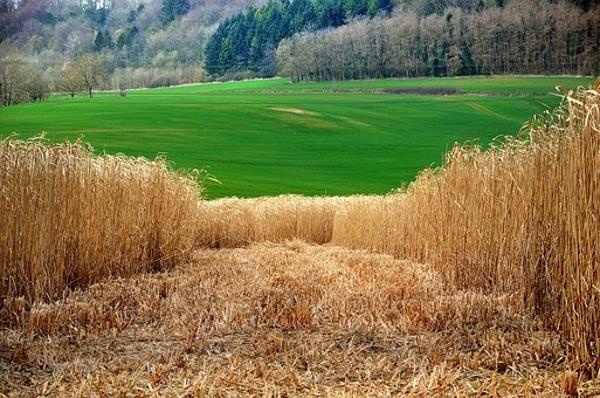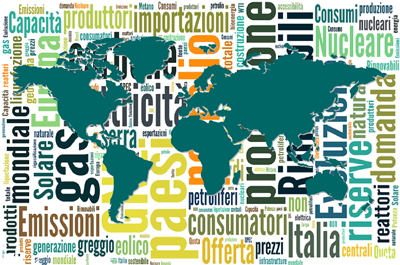Accessibility to sustainable low-carbon biofeedstock is one of the key drivers to achieve a low carbon EU economy by 2050.
In this context, one of the key questions regarding the role of biofeedstocks in the energy sector is the potential availability of sustainable biomass in the EU and UK, and under which conditions and assumptions biomass availability can be improved and biomass potential maximised safely and sustainably by 2050 without any negative impacts (e.g. by preserving natural high-value areas, maintaining and improving biodiversity, and reducing the use of arable land as well as the use of fertilisers and other chemical inputs).
This article is a summary of a study undertaken by Imperial College Consultants at the request of Concawe, to estimate the potential sustainable biomass availability in the European Union and the UK by 2030 and 2050, and to assess the production of sustainable advanced biofuels for 2030 and 2050 on the basis of this biomass potential.
Which feedstocks are biomass?
The work presented in the report covers domestic (EU-27 + UK) feedstocks of agricultural, forest and waste origin included in Annex IX of RED II (Parts A and B as shown in Table 1) and imports to the EU. RED II and Annex IX set the regulatory framework for advanced biofuels, bioliquids and biomass fuels. Within the 14% target of renewables in the transport sector, the RED II Directive establishes a dedicated target for advanced biofuels and biogas produced from the feedstocks listed in Part A of Annex IX. The contribution of advanced biofuels as a share of the final energy consumption in the transport sector shall be at least 0.2% in 2022, at least 1% in 2025 and at least 3.5% in 2030 (double counted). Part B of Annex IX also includes feedstocks for the production of biofuels and biogas for transport, for which the contribution towards the minimum share of 14% shall be subject to a cap.
Table 1. Biomass Feedstocks from RED II Annex IX (Part A and B) considered in the Imperial College study
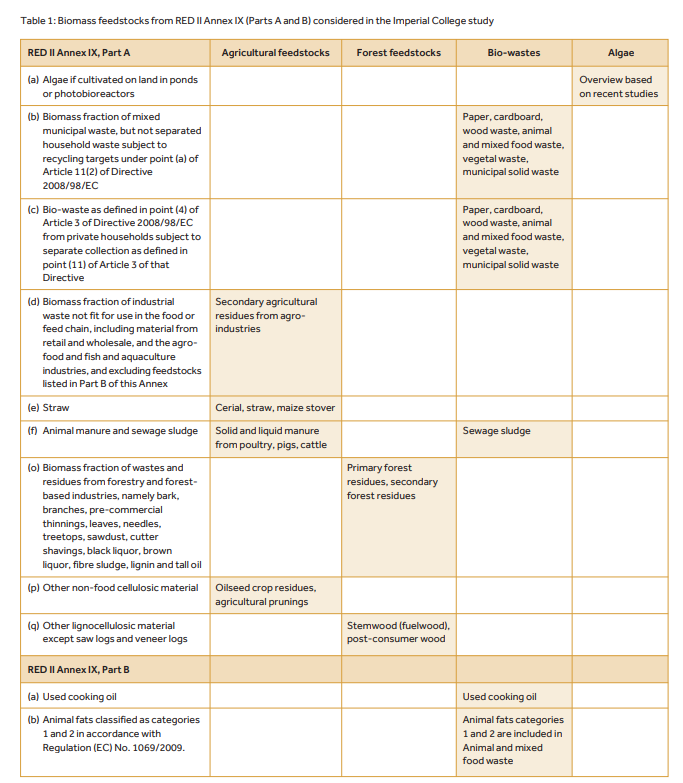
Source: Imperial College Study
Scenarios for future biomass availability
Three scenarios have been analysed in the study to estimate future biomass availability:
Scenario 1. Low biomass mobilisation. This scenario assumes low mobilisation of biomass for both 2030 and 2050. Key assumptions include: farming and forest practices at 2020 levels; a small proportion (25%) of unused, abandoned and degraded land is used for biomass crops; and emphasis is placed on the use of residues and wastes in the energy and non-energy bio-based sectors.
Scenario 2. Improved mobilisation in selected countries due to improvements in cropping and forest management practices. These practices take place in countries with: (i) high biomass availability and in combination with good institutional framework (Germany, France, Sweden, Finland, Italy, United Kingdom, Austria, Spain); or (ii) low biomass supply costs (Poland, Romania, Czech Republic, Hungary, Bulgaria). Key assumptions include: improved management practices in (i) agriculture, such as crop rotation, cover crops, agroforestry, etc., which can improve soil and increase biomass productivity, and (ii) forestry, such as improved harvesting techniques, fertilisation (where possible), storage and transport optimisation, etc.; a significant proportion (50%) of unused, abandoned and degraded land is used for biomass crops; and l emphasis remains on the use of residues and wastes in the energy and non-energy bio-based sectors.
Scenario 3. Enhanced availability through research and innovation (R&I) measures as well as improved mobilisation due to improvements in cropping and forest management practices. Key assumptions include: improved management practices in (i) agriculture, such as crop rotation, cover crops, agroforestry, etc., which can improve soil and increase biomass productivity, and (ii) forestry, such as improved harvesting techniques, fertilisation (where possible), storage and transport optimisation, etc.; a significant proportion (75%) of unused, abandoned and degraded land is used for biomass crops; improved R&I; and emphasis remains on the use of residues and wastes in the energy and non-energy bio-based sectors.
For these scenarios, up-to-date assumptions are considered, that are in line with the European Green Deal, about the sustainable increase of available European biomass, acknowledging the biophysical restrictions of land resources and feedstocks as well as the adverse effects of climate change.
In all the scenarios, biodiversity has been carefully considered based on the two following principles: (i) conservation of land with significant biodiversity values; (ii) land management minimising effects on biodiversity.
Results
This section presents the estimated sustainable biomass potentials for bioenergy (transport, heat and power) (excluding demand for non-energy uses (plastics, pharmaceuticals, etc.). The potential available for energy purposes was estimated after carefully considering the demand for biomass in the non-energy sectors and subtracting it from the total biomass potential. The estimated figures for 2030 range from 208–344 Mtoe for 2030. The respective numbers for 2050 remain similar and range from 215–366 Mtoe. The reasons why potentials remain unchanged between 2030 and 2050 despite improvements in biomass mobilisation and increased innovation for higher yields are mostly related to: strong pressure for the sustainable use of land and water resources, including a 30% reduction in arable land by 2050; the fact that improvements in forest management are slow due to the long growing cycles of forests that prohibit fast changes in growth of potentials; and increased awareness of the need for waste reduction and strong commitments to recycling.
Figure 1. Estimated sustainable biomass potentials (RED II Annex IX, Parts A and B) that can be available for bioenergy in 2030 and 2050
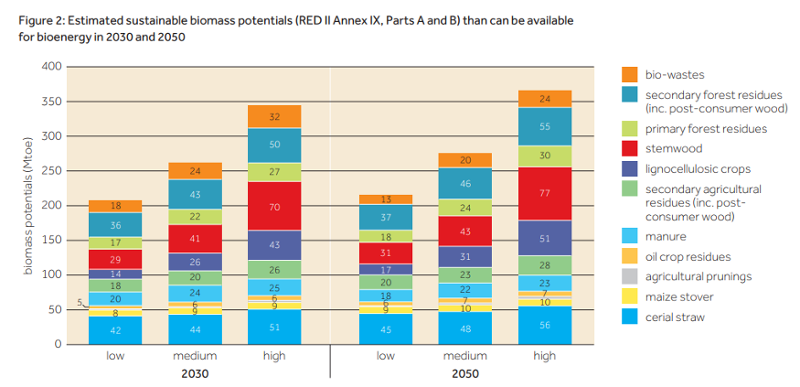
Source: Imperial College Study
Figure 2 presents comparative estimates of the biomass potentials for bioenergy in the Imperial College, DG RTD and JRC studies based on feedstocks from Annex IX, Parts A & B (as detailed in Table 1).
Figure 2. Comparative estimates for biomass potentials (Mtoe) for bioenergy in the Imperial College, DG RTD and JRC TIMES studies for 2050
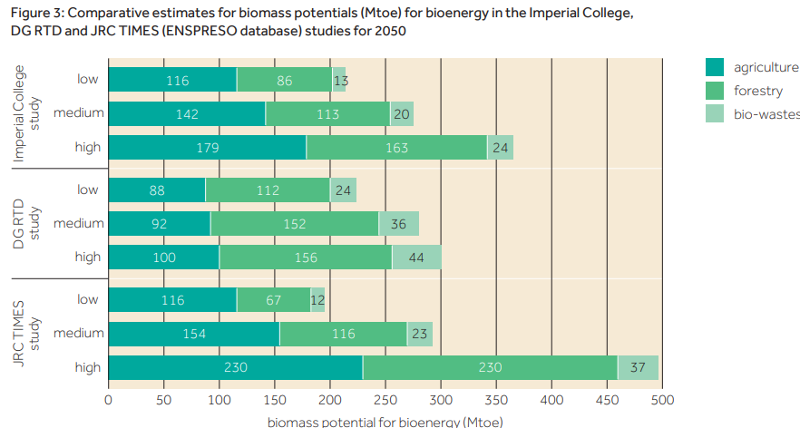
Source: Imperial College, DG RTD and JRC TIMES (ENSPRESO database)
Imperial College’s estimation of biomass availability in the High scenario is 22% higher than in the DG RTD high scenario, and 26% lower than JRC TIMES high scenario. The JRC TIMES high scenario gives the technical maximum that can be achieved, without sustainability criteria, allowing dedicated cropping in high biodiversity lands and including first-generation biofuel crops.
A look into transport demand
The total estimated net biomass available for biofuel production, after including imports (amounting to 48 Mtoe in 2030 and 56 Mtoe in 2050) and allowing for the use of biomass for other non-transport-related uses (power, industry, service, agriculture and residential, amounting to a total of 130 Mtoe in 2030 and 170 Mtoe in 2050 according to the European Commission’s Impact Assessment is estimated between 126–262 Mtoe for 2030 and 101–252 Mtoe for 2050.
It should be noted that a part of the total sustainable biomass available for bioenergy could potentially be used for power, industry, services and agriculture, and residential heat demand in 2030 and 2050; this will decrease the amount of feedstock available for advanced biofuel production.
Conclusions
Based on the CONCAWE study, commissioned to Imperial College, the estimated net amount of biomass available for bioenergy ranges 208–344 Mtoe in 2030, and 215–366 Mtoe in 2050. This share is more than half of the total available for all markets; signal that energy will attract the largest quantity of raw materials considered sustainable in the EU in the coming years. Important R&D developments and implementation of improved management practices are required to achieve this potential availability of biomass. Even if the potential is there, the supply chain would need to be developed to mobilise these resources.
On the other hand, the estimation of the potential availability of sustainable biomass in the EU and the UK by 2030 and 2050 is focused only on the domestic feedstocks of agricultural, forest and waste origin included in Annex IX of RED II (Parts A and B). This is considered a conservative hypothesis, this is considered a conservative hypothesis assuming that more potential newcomers to Annex IX are currently being analysed by the EU Commission. The potential of available sustainable biomass could therefore vary according to this evolution.
This article is a summary of a study undertaken by Imperial College Consultants at the request of Concawe, the results of which have been published in a report entitled Sustainable biomass availability in the EU, to 2050. [1] The work presented in the report covers only domestic (EU-27 + UK) feedstocks of agricultural, forest and waste origin included in Annex IX of RED II (Parts A and B as shown in Table 1) and imports to the EU

